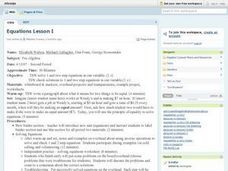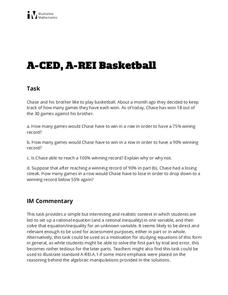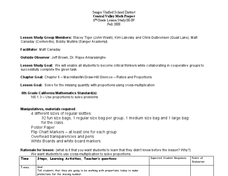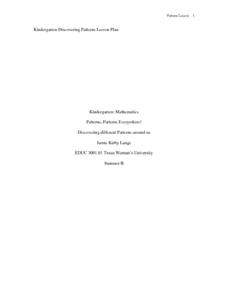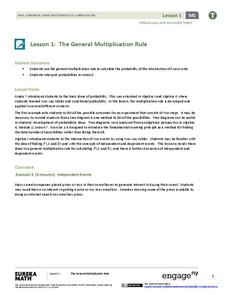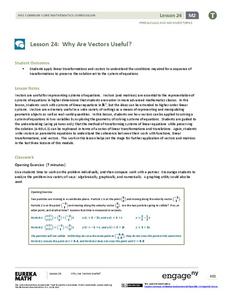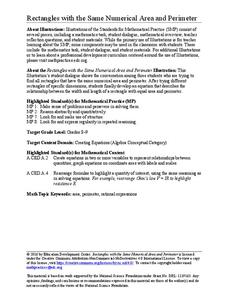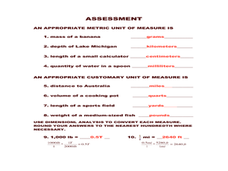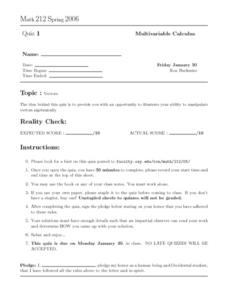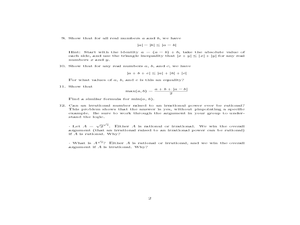Curated OER
Equations Lesson 1
Middle schoolers engage in a study of equations and how they are solved using algebraic methods. This overrides the fact of guessing as done in earlier grades. They cover the concept of inverse operations as the main way to manipulate...
Curated OER
Basketball
Tap into the competitive nature of teenagers as your class practices setting up and solving rational equations. This activity starts with a specific ratio of games won to games played, then asks how many more games must be played to...
Curated OER
Relations
Students identify, compare, and analyze shapes and numbers. In this analogies and comparison math lesson plan, students warm up by completing 4 worksheets to familiarize themselves with analogies. In small groups, students are challenged...
Curated OER
Using Proportions to Solve Problems
Skittles and math? Pupils will work as a class to determine how many orange Skittles are in a large bag by using proportions. They will problem solve, estimate, and share their thinking. Then, they will each receive a small bag of...
Curated OER
Models with monomials and polynomials
High schoolers participate in a lesson that focuses on the concepts of combining monomials to make polynomial expressions. They use algebra tiles to complete the exercises in the lesson. This is hands-on learning with successive problem...
Curated OER
Factoring Trinomials
Students factor trinomials using algebra tiles and blocks. In this algebra lesson plan, students complete a trinomials station activity. They work backwords to find their answers and discuss their steps in a group.
Curated OER
A Penny Saved is a Penny Earned
Students explore the concept of exponential growth. For this exponential growth lesson, students manipulate power models with base 2. Students discuss what would happen if you doubled a penny over the course of 20 days. ...
Curated OER
Determining Red-Shift in a Receding Star
Young scholars practice manipulating algebra formulas with more than one variable. They examine the topics of velocity, wavelength and frequency. They determine the amount of red-shift in a receding star.
Texas Woman’s University
Patterns, Patterns Everywhere!
Not only is pattern recognition an essential skill for young children to develop, it's also a lot of fun to teach! Over the course of this lesson, class members participate in shared readings, perform small group...
EngageNY
The General Multiplication Rule
In the first installment of a 21-part module, scholars build on previous understandings of probability to develop the multiplication rule for independent and dependent events. They use the rule to solve contextual problems.
EngageNY
Why Are Vectors Useful? 2
Investigate the application of vector transformations applied to linear systems. Individuals use vectors to transform a linear system translating the solution to the origin. They apply their understanding of vectors, matrices,...
EduGAINs
Introduction to Solving Linear Systems
Word problems offer class members an opportunity to learn the concept of solving linear systems using graphs. Individuals choose a problem based upon preferences, break into groups to discuss solution methods and whether there...
Balanced Assessment
Disc-Ness
Transform your scholars into mathematicians as they develop their own geometric definition. The task asks individuals to compare cylindrical objects and create a definition for the disc-ness of each object. They may use any method and...
Mathematics Assessment Project
Maximizing Area: Gold Rush
Presenting ... the gold standard for a lesson. Learners first investigate a task maximizing the area of a plot for gold prospecting. They then examine a set of sample student responses to evaluate their strengths and weaknesses.
Education Development Center
Rectangles with the Same Numerical Area and Perimeter
Is it possible for a rectangle to have the same area and perimeter? If you disregard units, it happens! In a challenging task, groups work to determine the rectangles that meet these criterion. The hope is that learners will naturally...
Curated OER
Algebra/Geometry Institute: Area, Circumference, Perimeter
Students solve area problems. In this area, circumference, and perimeter lesson, students solve area and perimeter problems using standard and metric units of measure. They identify the best customary unit of measure for a...
Curated OER
Math 212: Vectors
In this vector activity, students find the coordinates of a midpoint, compute the position of vectors, and write a vector equation. This two-page activity contains four problems.
Curated OER
Math 32 Worksheet: Quadratic Equations
For this quadratic equations worksheet, students solve 12 short-answer problems. Students find real and irrational solutions to given functions. Students raise irrational numbers to irrational powers.
National Security Agency
A Balancing Act: Solving Multi-Step Equations
Wow! Put on that thinking cap and solve multi-step equations. To solve equations, learners review the use of the distributive property and combining like terms. This three-day lesson comes with about 20 pages of worksheets, warm-ups,...
Curated OER
Prime and Composite Numbers with use of manipulatives (Elementary, Mathematics)
Students learn what prime and composite numbers are. They learn how to identify them by working in a group and demonstrating an understanding of one work problem with 100% accuracy using the manipulatives provided.
Curated OER
Love Algebra?
Eighth graders, while in the computer lab, access a web site to help them utilize manipulatives of cups and tiles to develop the skills necessary to understand multi-step equations. They assess the relationship between cups and tiles and...
Curated OER
Review for the Algebra One SOLs
Students review the standards for Algebra I. Using the text, they discover two problems that match each standard and solve them showing all steps on paper. They create a PowerPoint slide for each problem and go through the correct...
Flipped Math
Calculus AB/BC - The Fundamental Theorem of Calculus and Accumulation Functions
Connect integrals with differentiation. The beginning of the video introduces the definition of an accumulation function. Scholars learn about the relationship between integrals and derivatives. Using what is commonly known as Part Two...
Illustrative Mathematics
Building an Explicit Quadratic Function by Composition
Use equivalent expressions to reveal information about their graphs. Pupils verify that two quadratic functions are equivalent. By comparing the two expressions, they determine the vertex, the zeros, the y-intercept, and the...
